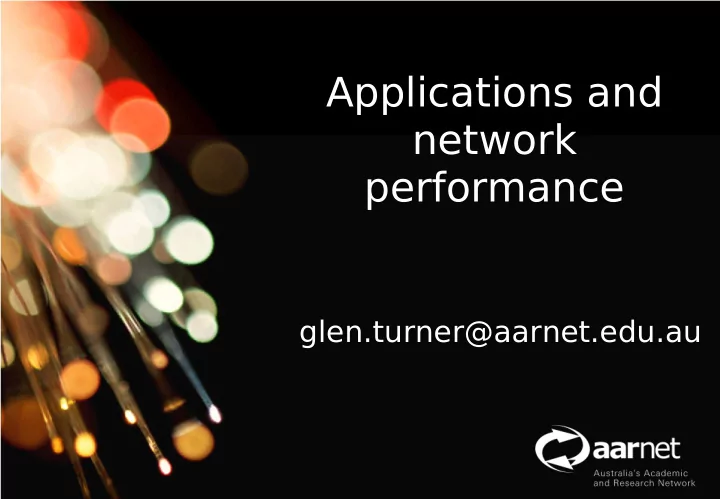

Applications and network performance Network Operations glen.turner@aarnet.edu.au
How long? 600ms 2
TCP basics • Slow start • Congestion avoidance 3
Inter-flow fairness • Connections don't share bandwidth evenly – The size of the effect varies greatly by TCP algorithm • So adding more connections may not improve the amount of data transferred • Connections from further away always lose 4
Network engineering 5
Media bit error rate • Looks like congestion to TCP • If bad enough TCP never leads slow start Pick the bottleneck 54Mbps WLAN with 3% loss 12Mbps ADSL with 0% loss 6
Configuration errors • 90% fixed by not touching the speed and duplex knob 7
Routers are good • Forwarding plane is in hardware – Low jitter – Accurate policing and shaping – Treating one flow doesn't effect other flows • Big buffers • Considered choice of queue algorithms • Improving defaults 8
Except for one odd type of router • These are usually PCs – Quantisation of output • Shaping leads to huge bursts upon clock ticks – Treating one flow adds jitter, or even loss, to another • Small buffers • Defaults are wrong – Queuing EF data in with BE data – FIFO rather than RED queues 9
Operating systems are better • Good TCP implementations – Modern TCP algorithm • TCP buffer auto-tuning is improving • 64-bit operating systems make more than 0.5GB available to networking • This is a systems administration challenge – You want to run Fedora Core in x86-64 mode, maybe with the Web100 kernel patch – You want to run Windows Vista, it has no server version – They are the very last place sysadmins want a production service 10
Computers are cheap • In the worst meaning of the term – Gigabit ethernet adapters not running at 1Gbps – Disk I/O buses that won't bus, working with only one drive – RAID hardware that runs in BIOS software – Interrupt controllers that drop interrupts • By the time you benchmark all this, your test platform is outdated 11
Applications 12
Make round trip times count • We can increase bandwidth but not the speed of light 13
Avoid application windows • Application windows need to be larger than the bandwidth-delay product too. • Writing one disk block or one window of disk blocks. • Using a windowing mechanism 14
Loss of TCP estimates • When your program is not sending data the TCP estimate is degrading • When it degrades enough, slow start mode is entered • while (running) { get_data(block); process_data(block); } • Use a reader thread and a writer thread with a BDP-sized buffer between them. 15
What TCP wants to do • Stream data continuously from disk to the network • Operating systems optimise this to one system call sendfile(file, socket) • If you do something different expect to fix performance problems, perhaps expensively – SSL accelerators for HTTPS – TCP offload adapters for iSCSI 16
Caches • If moving data a long way is hard, let's cache it close to the user • Has the performance problem simply moved to populating the cache? • The cache needs to be closer to the user, measured using milliseconds, not kilometres – Seattle is often closer than Indonesia in round-trip time milliseconds 17
Systems design and loading • TCP sender makes the decisions • TCP receiver does the work • So where do I place the application's load? – HTTP chose the client, since the server would then be simple enough to serve huge numbers of people – A server with just one client should take the load 18
Is your application a DoS attack? • Does it use UDP? – Does it send more data than it receives prior to authentication? – Is it congestion aware? – What happens when the user holds the mouse down • Hint: don't open fifty 10Mbps connections 19
Constant bit rate sources • Data acquisition devices run a analogue-digital converter and pump out n samples per second whatever else is happening • Use UDP with congestion detection rather than TCP – TCP can enter slow start, which may have lower bandwidth than the sampling rate • Not dropping the occasional sample is very difficult, even the operating system won't play a CD without drops when under load 20
Avoid negotiations • TCP is trying to discover the available bandwidth, why is our application sending small, atypical packets. • Compare – Telnet • Will, won't, Will, won't, ... – HTTP • This is what I want, do your best 21
Avoid minor transactions • FTP – AUTH GSSAPI 530 AUTH KERBEROS 530 USER anonymous 331 PASS ... 230 CWD pub 200 BIN 200 RETR afile.bin 150 QUIT 221 • These could have been a single chained transaction, as CIFS does 22
Move up the stack • Compare the effectiveness of round-trip times between ODBC and SOAP and REST. – ODBC issues a single SQL statement – SOAP issues a single transaction – REST issues a part of a business function 23
Anticipate the entire transaction • HTTP sends HTML, which is interpreted, which then requests style sheets and images. • Style sheets can be provided with the HTML, so do that – Use a content management system so that this “hardcoding” is manageable • A simple feature allows images to accompany the HTML text but it not used – This feature is used for HTML e-mail 24
API and programmers • Why do the network APIs allow applications programmers to do the wrong thing. File I/O is buffered, why isn't network traffic. • RPCs look like a function call. Chaining RPCs makes sense from a network layer, but breaks the abstraction presented to the programmer (chained function calls?). We need a new abstraction for the RPC mechanism, perhaps similar to parallel programming monitors. 25
Recommend
More recommend